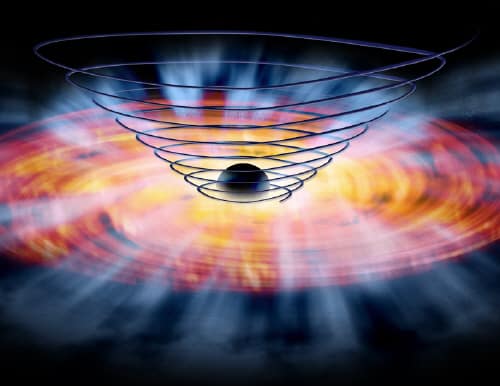The way in which black holes suck in matter from neighbouring stars is a fundamentally magnetic process and not just caused by gravity. That's the conclusion from new measurements of the X-rays emitted by the gas surrounding a nearby black hole in the Milky Way. Although predicted by theory over 30 years ago, this is the first time that this effect has been seen. The result -- based on measurements from the Chandra X-ray observatory -- could affect theories on how matter falls onto black holes and other compact objects (Nature 441 953).

Black holes have such strong gravitational fields that they attract large amounts of neighbouring gas and dust. This material forms an “accretion disk” around the hole – rather like the rings of Saturn. As the disk is compressed, frictional forces encountered by the material make it heat up and emit X-rays, which can be detected by astronomers to provide observational evidence for the black hole.
However, astronomers have long known that gravity alone is not enough to make the gas fall into a black hole. Before it can spiral inwards, the gas must also lose some of its orbital angular momentum (or spin) otherwise it would simply remain in orbit around the black hole indefinitely.
Until now, it was not clear how this angular momentum was removed, but scientists suspected that it was due to magnetic turbulence in the disk. This turbulence generates friction in the disk and drives a wind from it. The wind can carry away the angular momentum and therefore allows matter to fall into the black hole.
Jon Miller of the University of Michigan and colleagues have now produced the first observational evidence that magnetic fields are indeed responsible for this effect. Using NASA’s Chandra X-ray Observatory, the team studied a stellar-mass black hole in the Milky Way called GRO J1655-40 As intergalactic distances go, GRO J1655-40 is relatively nearby at “just” 10,000 light years away. The X-ray spectrum of the black hole shows that the speed and density of the wind from J1655’s disk corresponds to theoretical simulations performed by the team for winds that are magnetically-driven.
According to Miller and co-workers, the new results could have implications for theories on how matter falls onto black holes, how black holes grow and how they affect their environment. The work could also be important for looking at the role of magnetic fields in accretion onto other compact objects, like neutron stars or white dwarfs.




